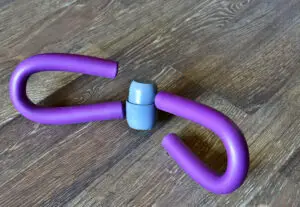Bosu balls have become a popular addition to the fitness community, primarily due to their versatility and the unique challenges they offer. Shaped like half of an exercise ball with a flat platform on the other side, these balance trainers can be used for a wide range of exercises that target different muscles and aspects of physical well-being.
Whether it’s working on balance, core strength, flexibility or endurance, a Bosu ball can bring an extra layer of difficulty to your workouts by providing an unstable surface to perform exercises on.
Having originated during the late 1990s, the Bosu ball’s popularity continues to grow as more people discover its benefits. Easily accessible, you can find Bosu balls in most gyms, sports stores, and online.
Many fitness enthusiasts incorporate it into their workout routines to improve coordination and stability while engaging various muscle groups to build overall strength.
With numerous Bosu ball exercises available, there is something for everyone, regardless of their fitness level. Incorporating this type of balance training into your regular fitness routine can help improve your posture, prevent injuries, and increase your athletic performance while making your workouts even more enjoyable and effective.
Bosu Ball Fundamentals
The Bosu ball, invented in 1999 by David Weck, is a versatile piece of fitness equipment that has gained significant popularity in the fitness industry.
Designed as a half ball balance trainer, it provides an unstable surface that challenges the body’s stability and balance, making it an excellent tool for a wide range of exercises.
One of the key aspects of a Bosu ball is its unique design, which features a flat base and a rounded, air-filled dome.
This combination allows for a variety of exercise positions, from placing the flat side on the floor for stability exercises to flipping it upside down to increase the challenge.
The unstable surface of the Bosu ball adds an extra level of difficulty to standard exercises, such as push-ups and squats, by engaging various core muscles and forcing the body to maintain balance.
Using a Bosu ball in your workout routine can offer multiple benefits. Some of these include:
- Improved balance and stability: The unstable nature of the Bosu ball forces the body to engage stabilising muscles, resulting in better balance and overall stability.
- Increased core strength: Many exercises performed on a Bosu ball require the engagement of core muscles, leading to a stronger core and better posture.
- Enhanced coordination and body awareness: Performing exercises on the Bosu ball helps develop a greater sense of body position and movement, improving overall coordination.
The versatility of the Bosu ball allows for a wide range of exercises targeting various muscle groups.
For beginners, it is important to start with basic exercises to familiarise with the equipment and build up balance and stability. A common starting point is the split squat, which is performed with one foot on the rounded side of the Bosu ball and the other foot on the floor, bending both knees to lower the body towards the ground.
As you become more confident in your balance and stability, you can progress to more advanced exercises, such as those targeting the core muscles. One example is the alternating knees to elbows, which begins with the Bosu ball flat-side-up, placing your hands on the ball in a push-up position and raising your knees across your body towards the opposite elbow.
In summary, the Bosu ball is a valuable and versatile tool in the fitness industry, providing an unstable surface for a myriad of exercises that challenge balance, core strength, and coordination.
By incorporating the Bosu ball into your workout routine, you can reap the benefits of improved physical fitness and overall well-being.
Balance and Stability
Incorporating balance and stability exercises into a fitness routine is essential for improving overall body coordination, muscle strength, and injury prevention.
One effective tool for enhancing balance and stability is the Bosu ball, a versatile piece of equipment which offers a range of exercises to challenge and develop core strength.
Balance training using a Bosu ball can improve the body’s proprioception, which is the ability to sense the position of different body parts in relation to each other and the environment.
This heightened awareness can enhance a person’s motor skills and overall movement quality. Moreover, balance training can decrease the risk of injuries, as it strengthens the muscles and ligaments around joints, providing better support during physical activity.
When performing exercises on a Bosu ball, the core muscles are automatically activated to keep the body stable. This results in an effective core balance workout that develops strength and endurance in the abdominal, back, and hip muscles, essential for maintaining proper posture and preventing low back pain.
In conclusion, incorporating Bosu ball exercises into a fitness routine can significantly enhance balance, stability, and core strength. Furthermore, it can reduce the risk of injury and improve overall body coordination and proprioceptive awareness.
With various levels of difficulty and its versatility in accommodating different exercises, the Bosu ball is a valuable fitness tool that can cater to individuals of all fitness levels, helping them achieve their goals with confidence and efficiency.
Versatility of BOSU Ball
The BOSU ball is a highly versatile fitness tool that can be used for a wide range of exercises. With its unique design, it offers an unstable surface which engages multiple muscle groups to improve balance and overall strength.
One of the key benefits of a BOSU ball is its adaptability for various types of exercises. It can be utilised for leg exercises such as squats and lunges, targeting your lower body strength. Additionally, the BOSU ball can be incorporated into core exercises, enhancing abdominal muscles and overall stability.
Besides lower body and core exercises, the BOSU ball is also effective for upper body workouts, including push-ups and planks, as well as cardio workouts. In each of these exercises, the use of the BOSU ball adds an element of instability, increasing the activation of smaller stabilising muscles along with the larger muscle groups.
When comparing BOSU balls to traditional stability balls, it is worth noting that BOSU balls have a slight edge in terms of lower body strength exercises, due to their unique design.
They allow for a greater variety of exercise options and can be utilised on both their flat and rounded sides.
In summary, the BOSU ball is a versatile piece of equipment that can enhance any workout session. Its design and inherent instability bring about multiple benefits, including improved balance, greater muscle activation, and the opportunity to perform a range of exercises targeting the whole body.
Footnotes
Bosu Ball Exercises
Bosu ball exercises are a fantastic way to improve balance, stability, and core strength. Incorporating a Bosu ball into your home gym workout routine can add a new level of challenge to many traditional exercises. In this section, we will cover several exercises that utilise the Bosu ball effectively:
Bosu Ball Squat
The Bosu Ball Squat is a great way to enhance the traditional squat exercise, which primarily works the glutes, quads, and hamstrings. With the Bosu ball, you add an element of balance and stability. To perform this exercise:
- Stand on the flat side of the Bosu ball with your feet shoulder-width apart.
- Slowly lower yourself into a squat position, keeping your chest up and your knees tracking over your toes.
- Rise back up to the starting position, engaging your glutes and core throughout the entire movement.
Pushup on Bosu Ball
The Pushup on Bosu Ball offers a more challenging variation of the standard pushup, targeting the chest, shoulders, triceps, and core muscles. To perform this exercise:
- Place the Bosu ball flat side up.
- Begin in a high plank position with your hands gripping the outer edge of the ball and your legs extended behind you.
- Lower your chest towards the Bosu ball, keeping your body in a straight line.
- Push back up to the starting position, maintaining proper form throughout.
Side Squat on Bosu Ball
The Side Squat on Bosu Ball is an excellent exercise for targeting the glutes, quads, and inner thigh muscles. To perform this exercise:
- Stand on one side of the Bosu ball, with one foot on the dome and the other on the ground.
- Lower into a squat position, shifting your weight onto the foot that is on the Bosu ball.
- Push up through your grounded heel, returning to the starting position.
- Repeat on the opposite side for a balanced workout.
Bridge on Bosu Ball
The Bridge on Bosu Ball adds a stability challenge to the classic glute bridge exercise, engaging the glutes, hamstrings, and lower back muscles. To perform this exercise:
- Lie on your back with your feet placed on the dome of the Bosu ball.
- Lift your hips off the ground, squeezing your glutes and keeping your core engaged.
- Hold for a few seconds, then lower back down to the starting position.
- Repeat for the desired number of repetitions.
Burpees with Bosu Ball
Burpees with Bosu Ball add an extra level of difficulty to the traditional burpee exercise, providing a full-body cardiovascular workout. To perform this exercise:
- Stand with the Bosu ball flat side up in front of you.
- Lower into a squat position, placing your hands on the edges of the ball.
- Jump your feet back into a high plank position, maintaining contact with the ball.
- Jump your feet back in, returning to the squat position.
- Stand back up and lift the Bosu ball overhead to complete one rep.
High Plank on Bosu Ball
The High Plank on Bosu Ball is an advanced exercise that targets the core, shoulders, and triceps. To perform this exercise:
- Position the Bosu ball with the flat side facing up.
- Place your hands on the outer edge of the ball, extending your legs behind you into a plank position.
- Hold this position, keeping your body in a straight line and maintaining your balance on the Bosu ball.
Sit-up on Bosu Ball
The Sit-up on Bosu Ball is a challenging exercise for strengthening your abdominal muscles. To perform this exercise:
- Sit on the dome of the Bosu ball, positioning your lower back against its curved surface.
- Place your feet flat on the ground, hip-width apart.
- Perform a sit-up, engaging your core and raising your shoulders off the Bosu ball.
- Lower back down to the starting position, maintaining control and balance throughout the movement.
Muscles Engaged by Bosu Ball Exercises
Bosu ball exercises offer a unique way to increase core strength, stability, and balance while working numerous muscle groups. They involve both resistance training and balance work, making them an effective tool for full-body exercise routines.
Here, we’ll discuss the primary muscles engaged by Bosu ball exercises encompassing the upper body, shoulders, knees, glutes, quads, and core strength.
The upper body is targeted by exercises such as Bosu ball push-ups, plank variations, and mountain climbers. These exercises help to strengthen and tone muscles like the chest, deltoids, and triceps. Doing them with the Bosu ball adds an extra challenge for the stabilising muscles around the shoulders and upper back, helping to improve overall coordination and posture.
One of the significant benefits of Bosu ball exercises is the increased engagement of the knees due to the unstable surface.
Squats, lunges and single-leg balance exercises are examples of Bosu ball activities that can strengthen the quadriceps, hamstrings, and the stabilising muscles surrounding the knees, thus enhancing joint stability and injury prevention.
Bosu ball exercises for the glutes include squats, bridges, and single-leg deadlifts. Engaging the glutes helps to maintain balance and stability throughout the movements, simultaneously improving the overall function of the lower body.
The main advantage of utilising the Bosu ball for various exercises is the improvement of core strength. Almost every movement performed on this unstable surface engages the abdominal, lower back, and oblique muscles, increasing their endurance and functionality.
Plank variations, crunches, and Russian twists with the Bosu ball challenge the core muscles, providing a dynamic workout.
Bosu ball exercises also target the shoulders effectively, especially with activities like overhead presses, lateral raises, and push-ups. By performing these movements on the Bosu ball, the shoulder stabilising muscles receive an added challenge, developing greater strength and stability.
Lastly, the quads are a crucial muscle group that benefit from Bosu ball training. Squats, lunges and step-ups actively engage the quadriceps, promoting muscle endurance and overall lower body strength.
With the added instability of the Bosu ball, these exercises become even more effective in targeting the quads and enhancing their development.
Improving Agility and Coordination
Bosu ball exercises are an excellent way to improve agility and coordination. The unique design of the Bosu ball, consisting of a half-sphere filled with air on a stable base, makes it a versatile piece of exercise equipment. This design requires users to focus on balance in addition to completing their regular workouts, improving both physical awareness and overall functionality.
One of the significant benefits of incorporating a Bosu ball into your exercise routine is the challenge it poses to the body’s coordination. When performing exercises on this piece of equipment, the body is forced to recruit multiple muscles to stabilise itself, enhancing coordination skills and full-body awareness. For example, when performing squats on a Bosu ball, the individual must engage their core and lower body muscles to maintain stability while performing the exercise.
Agility is another essential aspect of fitness that can be improved through Bosu ball exercises. With its unstable surface, the Bosu ball requires users to react and adapt quickly to maintain balance, which enhances overall agility.
Exercises such as lateral jumps or jump squats on the Bosu ball challenge the user to land softly and maintain their footing, boosting their ability to change direction and respond to various stimuli.
Additionally, the combination of balance, coordination, and agility training provided by the Bosu ball can lead to a reduced risk of injury. When individuals have excellent coordination and physical awareness, they are less likely to trip or fall during their daily activities.
Moreover, agility training can improve the body’s ability to react and adapt to sudden changes in direction, reducing the chances of strains and sprains during sports or other physical activities.
In summary, Bosu ball exercises offer a unique and engaging way to improve agility and coordination, leading to increased overall functionality and a reduced risk of injury.
Durability and Brands of Bosu Balls
When it comes to selecting a Bosu ball, durability plays a crucial role. High-quality materials and well-constructed products from reputable brands ensure long-lasting performance. To help you navigate through the best options, here is a list of some of the most prominent Bosu ball brands and their durable product offerings.
Bosu NexGen Pro: Highly regarded for its sturdiness, the Bosu NexGen Pro sets the bar high in terms of durability. With a 300-pound weight capacity, this model offers textured quadrants and rubberized feet to maintain stability during intense workouts. Being latex-free, it has an added advantage for users with latex allergies.
Original Bosu Trainer: As the original innovator of Bosu balls, the Bosu Trainer also stands out as a reliable and long-lasting option. With a weight limit of 300 pounds, this trainer is excellent for a variety of balance exercises. It comes with a workout DVD and a poster featuring 16 exercises, making it a popular choice for home use.
One environmental aspect to consider when choosing a Bosu ball is its “green” factor—meaning its sustainable and eco-friendly features.
Some Bosu balls are made from more environmentally friendly materials, such as recycled or biodegradable components. By opting for these products, users can contribute to a healthier planet while simultaneously enjoying their regular workouts.
In conclusion, it is crucial to choose a durable Bosu ball from a reputable brand to ensure a safe and effective workout experience—both for the individual and the environment. The Bosu NexGen Pro and Original Bosu Trainer are two excellent options that offer durability, stability, and reliable performance for those seeking to incorporate balance exercises into their fitness regimen.
My name is Ellis Francis and I have been a personal fitness trainer, sports nutritionalist and health and fitness advisor for over 25 years. I am the lead health and fitness advisor at https://awellnessbody.com.








